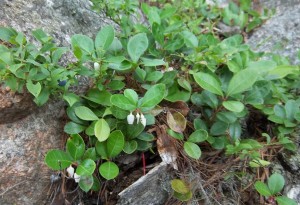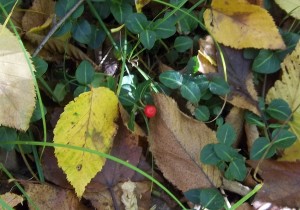When we hike in the late fall, early winter it can become difficult to determine what some of the plants along the trail are. Many are displaying their seed heads and dried leaves. There are some herbaceous plants that remain evergreen and are easy to identify. One of these beauties is a woody ground cover called Wintergreen (Gaultheria procumbens). The plant has shiny green leaves and red berries. The best ways to identify it is to break or crush a leaf then smell it. The aroma of wintergreen is wonderful. This plant has been used to flavor wintergreen gum, for teas and candies. You can distinguish this from Partridgeberry (Mitchella repens)which doesn’t smell like wintergreen by using this method.
Partridgeberry is also a wonderful evergreen ground cover with red berries. When you compare the leaves of the two you will also note Partridgeberry has a prominent light green vein running the length of the leaf. You commonly see these plants together, in an acid soil, in a woodland setting. They are beneficial to wildlife as food. The leaves and berries of Wintergreen are eaten by birds, mice, deer and chipmunks in the winter. Partridgeberry provides berries for turkeys, grouse, skunks and mice. These are two plants that are relatively easy to learn on late fall and winter hikes. Look for them on your next hike.



On many of our winter hike we find these red berries from both the wintergreen and patridgeberry.
I was wondering if they were edible to humans and if so when they are fresh to eat?